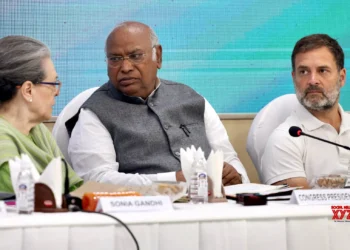Prime Minister Narendra Modi aims to propel India into the top tier of advanced semiconductor technology manufacturing — a “giant scale of ambition” to seize on the world’s desire to reduce reliance on China, said a New York Times report.
India has no history of fabbing chips and virtually none of the hyperspecialised engineers and equipment needed to launch such an initiative.
“Still, it says it will make them here — and soon. It took TSMC and other Taiwanese companies decades, driven by government spending and countless billions in capital investment, to get where they are,” the NYT report mentioned.
Making microchips also requires a lot of “bespoke ingredients”.
According to Union IT Minister Ashwini Vaishnaw, “India’s biggest chemical plants are near Dholera and could pump out the specialised gases and liquids needed to run any chip fab. Seaports and railheads can ensure high levels of connectivity.”
Dholera in Gujarat has been designated as the future home of India’s first “semicon city”.
In July, Modi had promised 50 per cent financial assistance to players wishing to set up semiconductor manufacturing facilities in the country.
At the SemiconIndia 2023 in Gandhinagar, he had said that “we are continuously carrying out policy reforms to accelerate the growth of the country’s semiconductor sector”.
Highlighting the country’s vast talent pool and skilled engineers, Modi stressed on the nation’s global responsibility and efforts to bolster the semiconductor sector.
He cited the recent initiatives like the approval of the National Quantum Mission and the introduction of semiconductor courses in over 300 colleges, aiming to produce more than 100,000 design engineers within the next five years.
According to the report, the government is “offering billions to build an entire semiconductor ecosystem on vast empty plots”.
“According to India’s government, the microprocessor chips that power all things digital will soon be fully made in India. It’s an ambition as unlikely as it is bold, and speaks volumes about Modi’s belief that he can propel India into the top tier of advanced technology manufacturing,” the NYT report noted.
Today, nearly all cutting-edge logic chips are made in Taiwan.
However, the Taiwan Semiconductor Manufacturing Company (TSMC), founded in 1987 by chip legend Morris Chang, “has been struggling to help America get its own fabrication plants or ‘fabs’ going in Arizona, with help from President (Joe) Biden’s subsidy-infused CHIPS Act”.
“India’s technology scene is exulting in the limelight. Its Chandrayaan-3 lunar lander reached the south pole of the moon in late August. Modi saw the Group of 20 summit as a platform to show off India’s digital-public infrastructure,” the report said.
According to the report, Modi has been telling nations not aligned with Beijing that India has an important role to play in “building a trusted supply chain”.
In June, US-based Micron Technology had announced plans to set up a new $2.75 billion semiconductor assembly and test facility in Gujarat.
Another US-based semiconductor company, Applied Materials, also announced plans to build a collaborative engineering centre in India with an investment of $400 million over four years.
Lam Research, a US supplier of wafer-fabrication equipment and related services to the semiconductor industry, announced a training programme in India for up to 60,000 high-tech engineers.
The three key announcements in the semiconductor sector made during PM Modi’s US visit will create a minimum 80,000 to 1 lakh direct jobs in India, according to Union Minister of State for Electronics and IT, Rajeev Chandrasekhar.
“The electronics industry created 10-12 lakh jobs in the last two years alone. The latest announcements, like by Micron, to make memory chips in India is an important milestone for us. I think there will be at least 80,000 to 1 lakh new direct jobs being created with these initiatives,” Chandrasekhar said in June.
“This is just a beginning as there is more to come as India rapidly grows as a significant and trusted partner to global electronics and semiconductor value and supply chain,” he added.






















